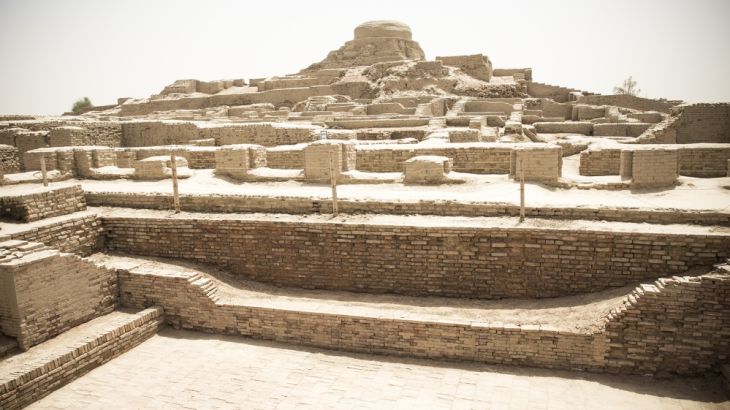Pakistan: Can a three-day conference really save Mohenjodaro?
Researchers, archaeologists and journalists were present in numbers at this ancient site in Pakistan. But are talks and discussions what the 4,000-year-old site really needs?

WATCH: Mohenjodaro 360 – A walkthrough of the ancient civilisation
Mohenjodaro, Pakistan – For three days last week, Mohenjodaro – which means mound of the dead – seemed full of life.
Keep reading
list of 4 itemsInside the pressures facing Quebec’s billion-dollar maple syrup industry
‘Accepted in both [worlds]’: Indonesia’s Chinese Muslims prepare for Eid
Photos: Mexico, US, Canada mesmerised by rare total solar eclipse
There was electricity, internet, staff were in action and, most importantly, there were visitors.
Based in Pakistan’s Sindh province, Mohenjodaro is an archaeological site dating back to 2,500BCE.
I visited the site last May, when temperatures exceeded the 50 degrees Celsius mark. Walking around the site last year, a feeling of emptiness and neglect had surfaced quickly. Talking to the officials stationed at Mohenjodaro and providing the guided tour, the feelings turned into facts.
Falling tourism numbers, funding issues and lack of interest by the government meant that Mohenjodaro was crumbling – in its existence and also in the minds.
But last year, there was a change at the helm of the Ministry of Culture, Tourism and Antiquities. Funds were released, as researchers, archaeologists, politicians and journalists were called to the three-day International Conference on Mohenjodaro and the Indus Valley Civilization.
![Visitor numbers went past the 1,000-mark on each of the days during the conference [Faras Ghani/Al Jazeera]](/wp-content/uploads/2017/02/25b5969e0f414c27941fe57f4ee53612_18.jpeg)
The site became lively. More than 1,000 people walked through the dates daily. A heavy security presence patrolled the area. Even the province’s chief minister graced the occasion, promising more funds.
Visitors walked through the ruins, researchers presented their papers, power supply remained uninterrupted and local craftsmen had an audience to whom they could present their work. The event was well-organised and carried out without a glitch.
However, the sudden burst of interest and adoration for Mohenjodaro was a temporary sight, according to locals, and will be forgotten as soon as the ministers and researchers pack their bags.
READ MORE: Pakistan’s Mohenjodaro is crumbling away
The show took place mostly under a large canopy – a stage for the presenters and politicians and adequate seating for the audience. A large majority restricted themselves to that canopy and the adjacent lunch area.
The research papers were presented, but only a minority was able to absorb and appreciate what was said.
“This should’ve been a small conference comprising researchers and those who can benefit from the exchange of ideas and information,” a Pakistani archaeologist told Al Jazeera.
“The amount of money spent on this event is enormous. They could’ve not only saved that by holding a smaller event but also used that fund on research and preservation instead.”
Staff present on-site shared the same thoughts. Changes, including on-site renovations, were obvious. But the disconnect between the department and its federal associates was visible. Those on-site were certain the glitz and glamour would be short-lived.
![Researchers and archaeologists encouraged community interaction in order to increase awareness and tourism figures [Faras Ghani/Al Jazeera]](/wp-content/uploads/2017/02/bf62f8b49f7945819d277643774c172f_18.jpeg)
“You see, most of the people present for the conference have never been here before … and they will never come again,” said one of the staff members.
“They see such a fantastic event and think things were working smoothly. The struggle starts again once they board their buses and flights back home.”
Sardar Ali Shah, the new minister, seemed adamant things will change and by hosting a grand event, the provincial government has confirmed there is no alternative but to improve things, he told Al Jazeera.
“We have undertaken a massive effort to restart preservation work and increase visitor numbers at not only heritage sites but also tourist sites that are neglected and in a bad state,” said Shah.
While he emphasised the large number of visitors, many local were turned away from the site due to the presence of foreigners in the delegation. And even for those who managed to enter, the research papers often seemed too technical and uninformative.
![Security officials were guarding the site and the visitors but with complete disregard for sign that warned them to stay off the ruins [Faras Ghani/Al Jazeera]](/wp-content/uploads/2017/02/6331309fb3e84bed91acb791a8491da2_18.jpeg)
Throughout the historical site, there were few noticeboards to educate visitors about the history and value of the bricks and walls.
Most visitors posed for selfies – some even climbing and running onto the ruins – before moving on to enjoy the massive buffet on offer.
For them, lack of entertainment options in the vicinity renders Mohenjodaro a place to visit, especially on weekends.
Engagement with the local community and youth interaction was not stressed upon – an issue highlighted by researchers from France and the US.
While Shah, on the surface, is keen to revive the neglected regions and industries, his tenure is not long enough. General elections are scheduled to take place next year. Once he vacates his seat, his replacement may not share the same plans.
His predecessor Sharmila Faruqi adequately put it to me last year: “In a country like Pakistan, we don’t talk about culture and tourism, unfortunately … it’s not easy to get funds for this, especially when your federal and provincial budgets are in deficit, and arts and culture are considered last”.
The organisers put on a grand show, managing to created a voice loud enough. But will that money and effort turn out to change Mohenjodaro? Many, including myself, doubt the path is as straightforward as that.
![Local craftsmen found a lot of interest in their handiwork by the visitors [Faras Ghani/Al Jazeera]While visitors appreciated the well-organised event, they wanted the efforts to continue beyond the three-day conference [Faras Ghani/Al Jazeera]Some researchers questioned the expenditure on the conference, instead saying the money would have been better spent on excavation, preservation and grants [Faras Ghani/Al Jazeera]](/wp-content/uploads/2017/02/aed2cb8d067f444d9125a08fc09f71ef_18.jpeg)